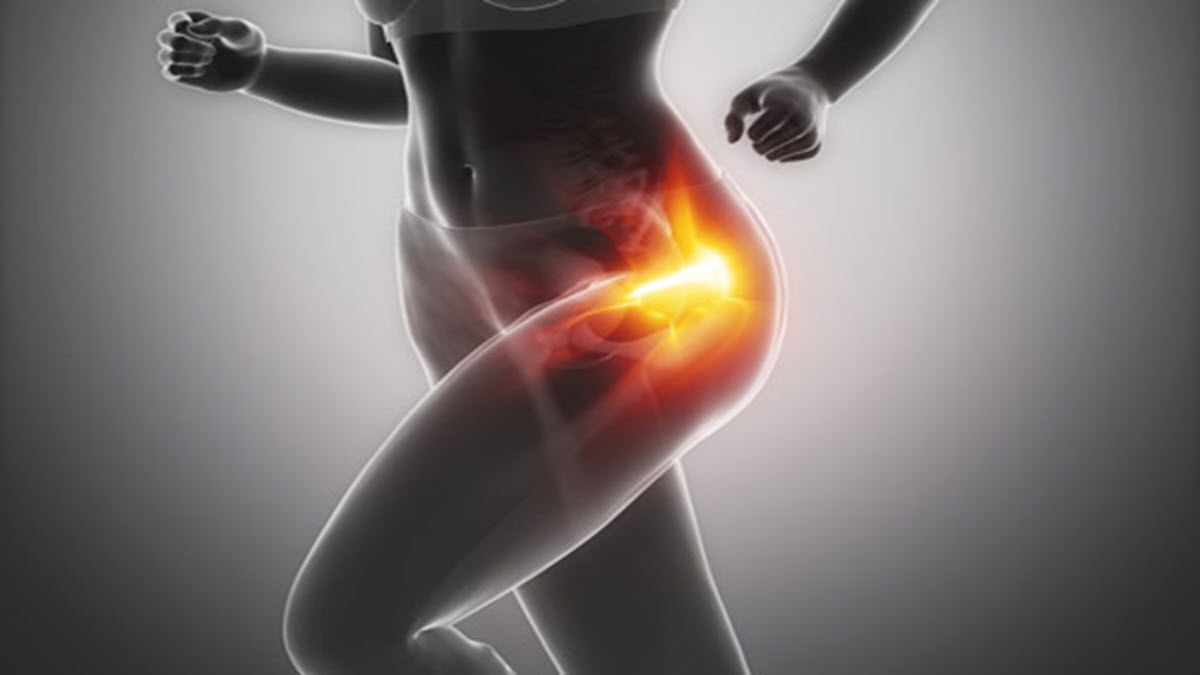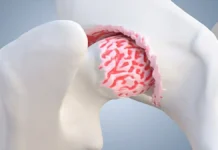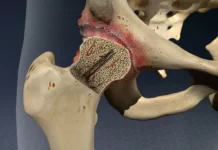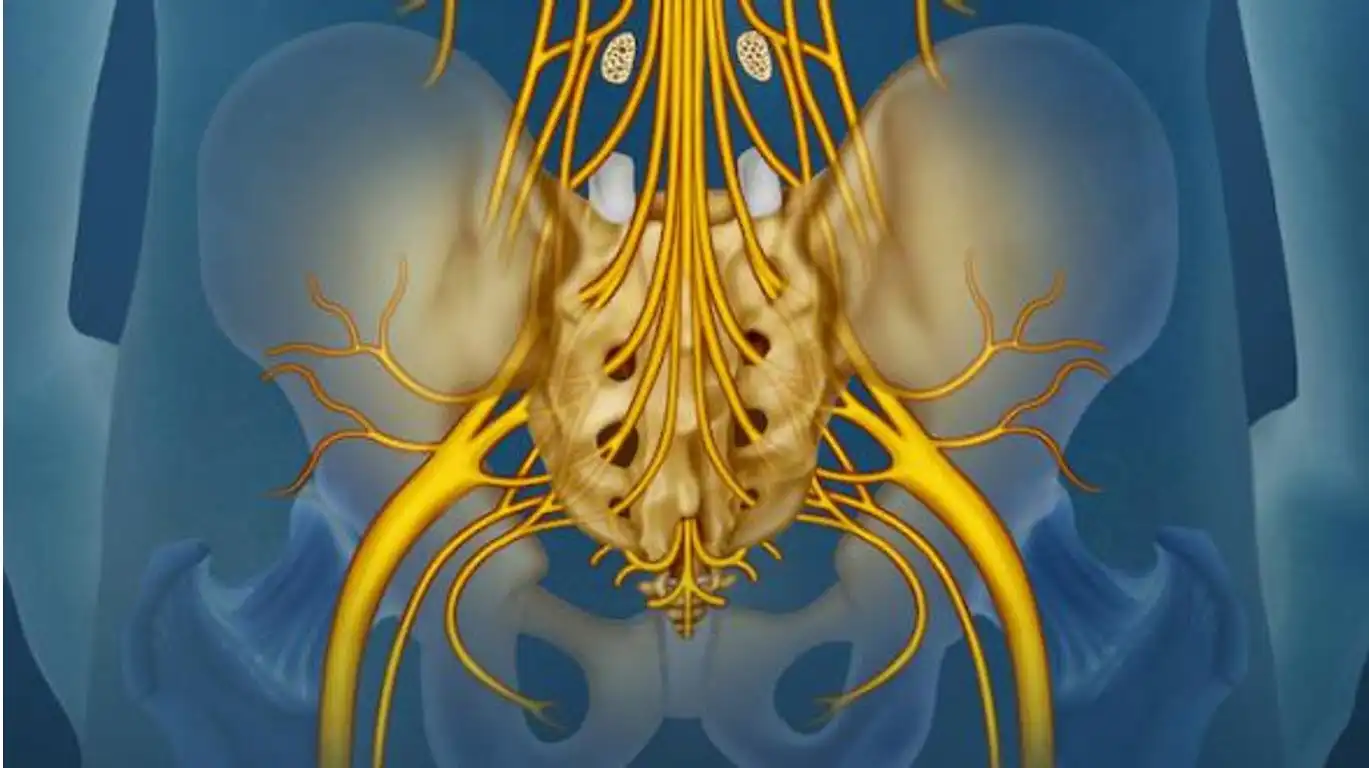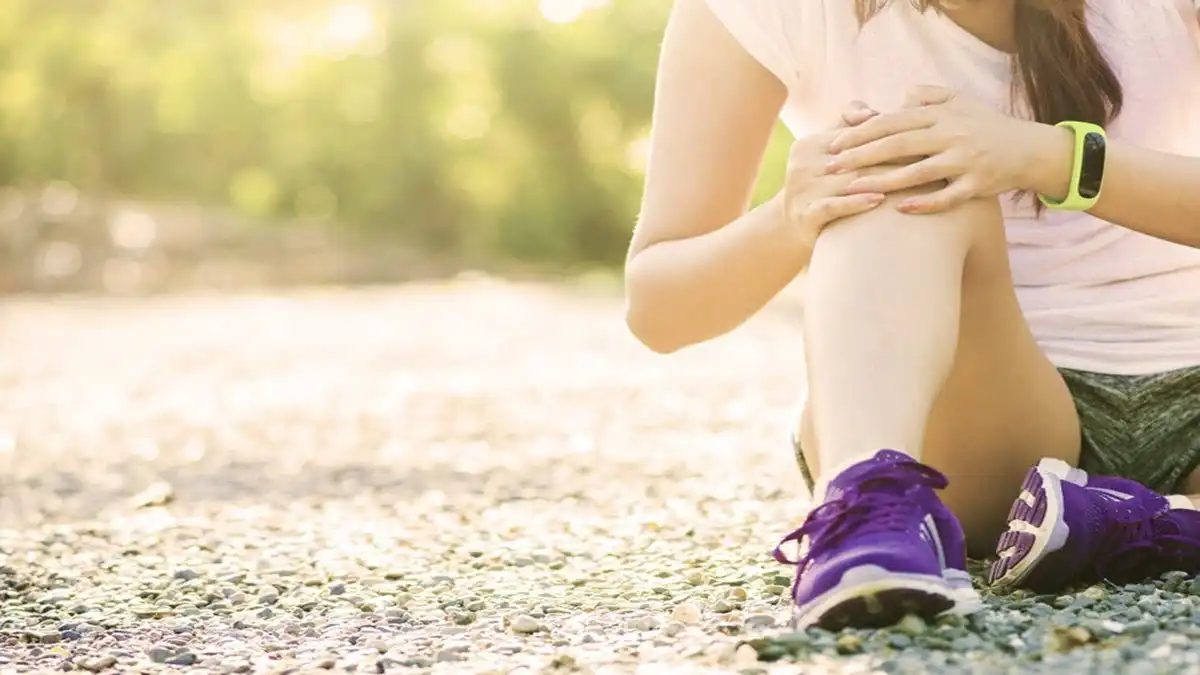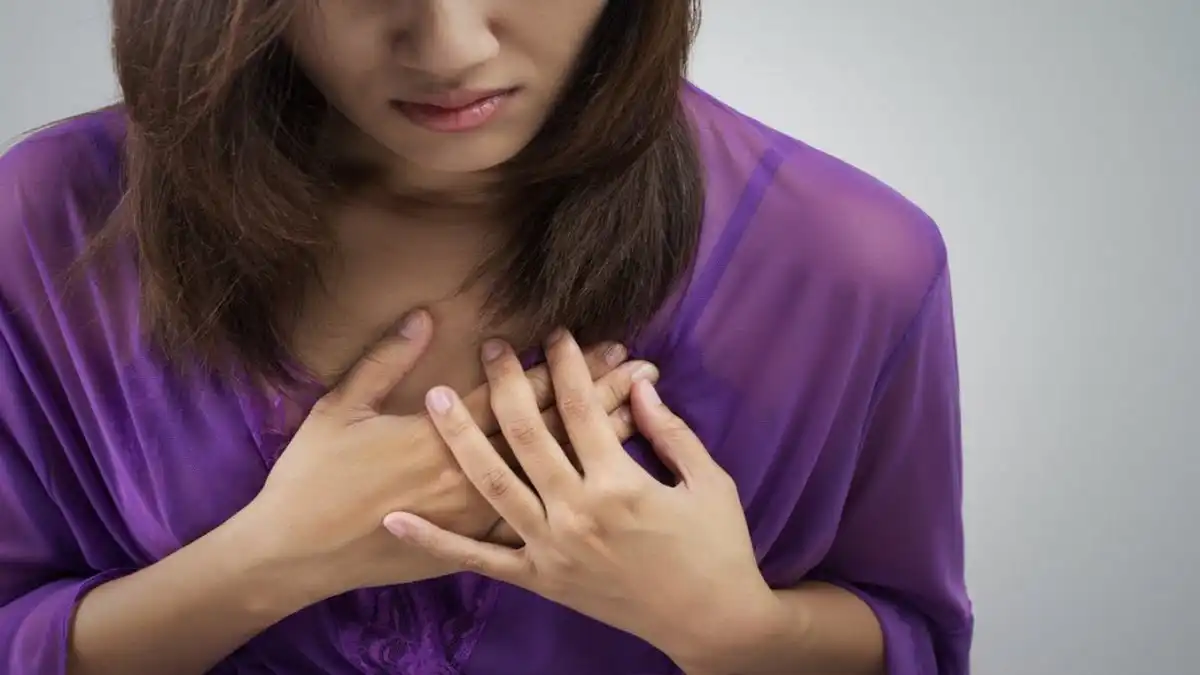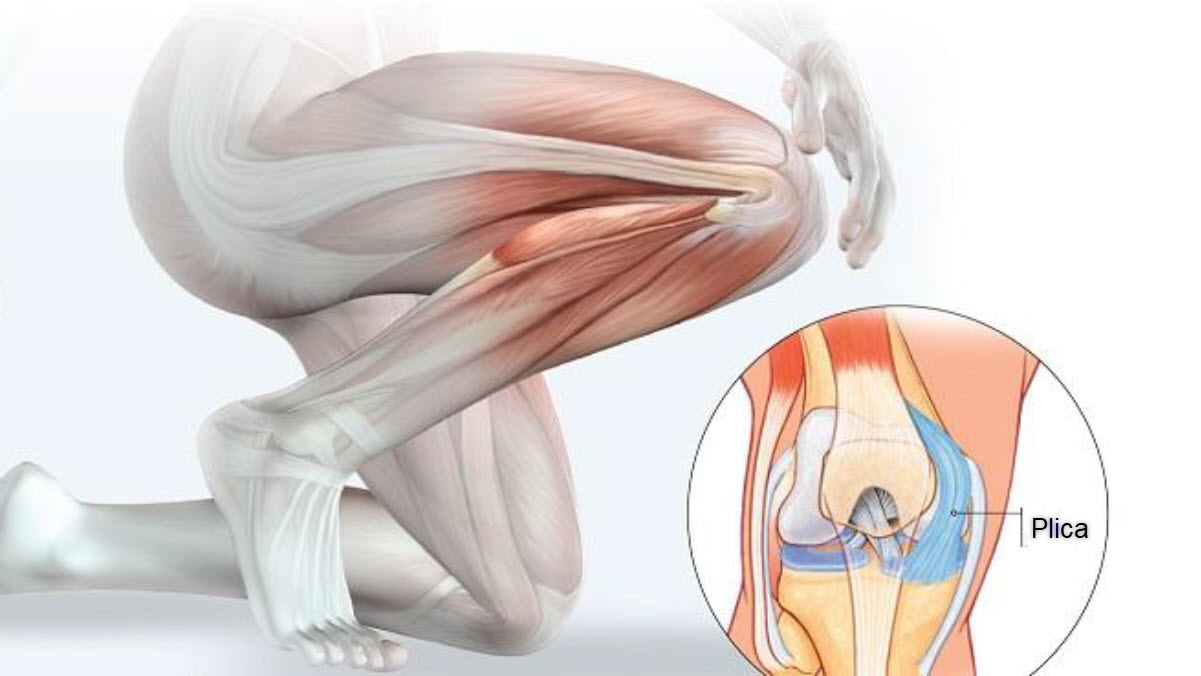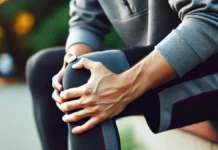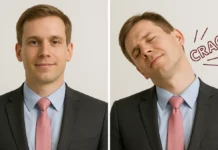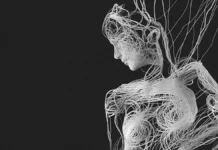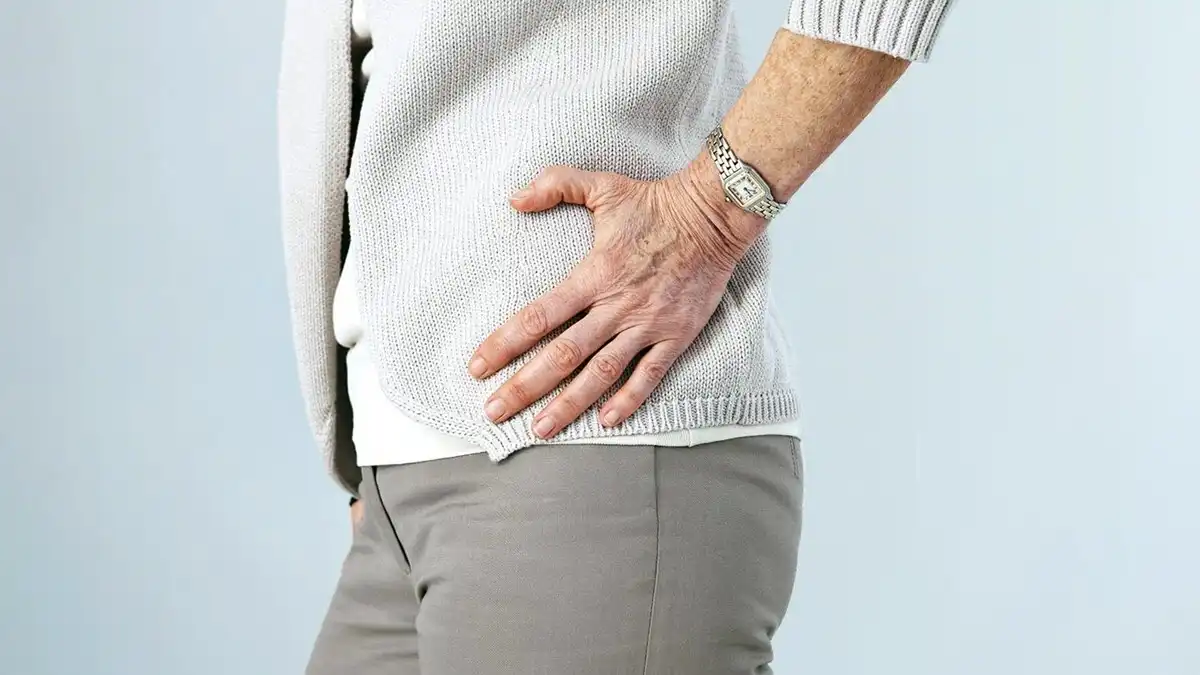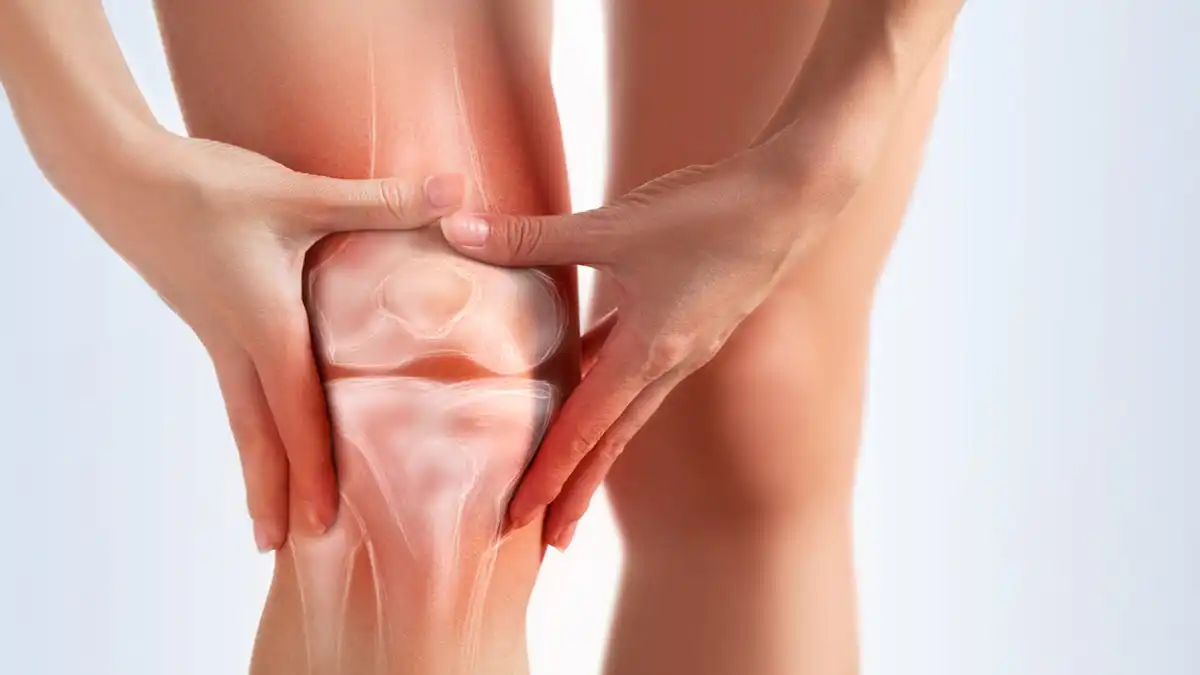Introduction: When the hip becomes painful
The hip is a powerful, mobile joint that plays an essential role in our daily lives. It allows us to walk, run, climb stairs, sit down, and stand up. However, when dull or sharp pain develops in this area, every movement can become a challenge. Among the many possible causes of hip pain, bursitis occupies a prominent place, although it is sometimes overlooked or confused with other conditions.
Hip bursitis, also called trochanteric bursitis when it affects the bursa located at the greater trochanter of the femur, refers to the inflammation of a serous bursa. These small sacs filled with synovial fluid act as a protective cushion between the bones, muscles, and tendons. When they become irritated, they can become painful, swollen, and restrict movement of the pelvis and lower limb. This type of pain can appear gradually or more suddenly, often following unusual exertion, direct trauma, or repeated microtrauma.
This clinical picture affects athletes as well as sedentary people, young adults as well as seniors, with a predominance in women after the age of fifty. It is not uncommon for trochanteric bursitis to become chronic if it is not properly managed at the first symptoms. The patient often describes pain located on the side of the hip, sometimes radiating to the thigh or buttocks, aggravated by lying on the affected side, prolonged walking or climbing stairs.
Understanding this condition relies on a good knowledge of the anatomy of the hip bursae, but also on a comprehensive approach integrating the biomechanical, postural, inflammatory, and emotional factors that can promote its onset or persistence. Indeed, bursitis is often not an isolated disease, but the local expression of a broader imbalance, whether articular, muscular, or postural. This is why an osteopathic approach can be particularly relevant, going beyond simple pain relief to restore lasting functional harmony.
This article aims to provide an update on hip bursitis, exploring its causes, symptoms, clinical forms, useful tests, available treatments, and prevention strategies. It will highlight the contribution of osteopathy in the detailed understanding of compensation chains, myofascial tensions, and joint imbalances that cause or are linked to this pathology. Through a rigorous yet accessible approach, this text is aimed at both patients and practitioners, in the spirit of Osteomag: inform, connect, and treat.
Because behind every hip pain, there’s a body story to listen to. And behind every inflammation, a body language to decipher. Understanding hip bursitis also means learning to hear what our body is trying to tell us, to better support it on the path to relief and regained mobility.
What is hip bursitis?
Hip bursitis is an inflammation of one or more bursae located around the hip joint. Bursae are small, sac-like anatomical structures filled with synovial fluid, located between the bony surfaces and soft tissues (tendons, muscles, ligaments). Their role is to act as shock-absorbing cushions and facilitate the smooth gliding of structures during movement. When a bursa becomes inflamed, the friction that should be reduced instead becomes a source of pain, irritation, and sometimes functional impairment.
The most common form is trochanteric bursitis, which affects the bursa located between the greater trochanter of the femur and the gluteal muscles, particularly the gluteus medius and gluteus minimus. It is sometimes confused with tendinopathy or sacroiliac pain, as symptoms can radiate to neighboring areas. Other bursae around the hip can also be affected, such as the iliopectineal bursa (at the front of the hip), the ischial bursa (below the ischial tuberosity), or the gluteofemoral bursa. However, trochanteric bursitis remains the most common and accounts for the majority of hip bursitis diagnoses.
Bursitis is said to be “acute” when it develops quickly, often in connection with trauma, unusual exertion, or occasional mechanical overload. It can also be “chronic,” evolving over several weeks or months, sometimes insidiously, with periods of remission and recurrence. In some cases, we speak of greater trochanteric pain syndrome , a broader entity that includes trochanteric bursitis, associated tendinopathies, and sometimes local fibrosis.
The mechanisms that cause bursitis are multiple. It can be a direct impact on the side of the hip, excessive stress (as in running or hiking), or prolonged postural constraints (lying on the side, pelvic imbalances, hyperlordosis). Sometimes, it occurs secondary to another biomechanical pathology: lumbar dysfunction, sacroiliac instability, unequal length of the lower limbs, or disorganization of the pelvic-femoral complex. These overload factors increase the pressure on the affected bursa, causing progressive inflammation.
Clinically, bursitis presents as lateral hip pain, well localized to the greater trochanter area, sensitive to direct pressure. This pain may radiate to the outer side of the thigh and worsen when walking, going up or down stairs, or lying on the affected side. The patient often describes nighttime discomfort, and sometimes a slight limp related to weight-bearing avoidance. On palpation, a specific point is painful, sometimes accompanied by swelling or a sensation of warmth.
It is important to note that bursitis can coexist with other local conditions, including tendinopathies or muscle tears. Therefore, an accurate diagnosis is necessary to guide management, taking into account the patient’s overall functional picture and history.
Understanding hip bursitis means recognizing an inflammation that is certainly local, but which is often part of a broader imbalance. A comprehensive view, integrating biomechanical, postural, and even emotional aspects, allows us to better identify the root causes of this pain and prevent it from becoming chronic. Osteopathy, as a holistic manual medicine, plays a key role here in restoring functional balance, releasing tissue tension, and supporting the body in its regulatory process.
Anatomy of the bursae around the hip
To fully understand hip bursitis, it’s essential to delve into the intricate anatomy of this region. The hip joint is one of the most mobile joints in the human body, but also one of the most stressed. This great freedom of movement requires sophisticated tissue organization to ensure fluidity, stability, and protection. The bursae play a key role in this functional architecture, facilitating sliding between structures and distributing mechanical stress.
A bursa is a small, flattened sac lined with synovial membrane that contains a thin film of lubricating fluid. Its primary function is to reduce friction between two moving structures, such as a tendon and a bone, or between two muscles. Several bursae around the hip fulfill this role, and their inflammation can cause localized and disabling pain.
The best known is the trochanteric bursa , located between the external surface of the greater trochanter (bony prominence of the femur) and the tendons of the gluteus medius and minimus. It is most often involved in cases of hip bursitis. Since the greater trochanter is a zone of convergence of muscular forces and a point of support during lateral decubitus, this bursa is particularly exposed to microtraumas.
There is also the gluteofemoral bursa , located deeper, between the gluteus maximus muscle and the vastus lateralis of the quadriceps. It helps reduce friction during hip extension, especially when the gluteus maximus is under heavy stress, such as when running or climbing stairs. Inflammation of this bursa can manifest as more diffuse pain than trochanteric bursitis, sometimes confused with gluteus medius tendinopathy.
In front of the joint is the iliopectineal bursa , located between the iliopsoas muscle and the anterior hip joint capsule. This bursa is involved in so-called psoas bursitis, which causes deep groin pain, often felt during hip flexion movements or when climbing stairs. It is an area less often palpated directly, but frequently involved in chronic pain of postural or functional origin.
Finally, further back, we find the ischial bursa , under the ischial tuberosity, between the bone and the gluteus maximus muscle. It is mainly used during prolonged sitting, especially on hard surfaces. Irritation of this bursa can cause lower gluteal pain, sometimes confused with sciatica or damage to the posterior cutaneous nerve of the thigh.
These bursae do not function in isolation. They interact with the surrounding muscles, ligaments, fascia, and joints. When an imbalance occurs, whether due to postural disturbances, muscle shortening, or impaired joint mobility, the pressure on a bursa can increase, promoting inflammation.
In some patients, anatomical variants or increased inflammatory sensitivity (such as in autoimmune or metabolic diseases) can also make these bursae more vulnerable. Therefore, a precise understanding of functional anatomy is essential to guide treatment, whether medical, rehabilitative, or osteopathic.
The osteopath, through his or her tissue-based and holistic approach, assesses not only the inflamed bursa, but also the surrounding structures that may be contributing to it: the sacrum, lumbar region, knee, foot, and even overall posture. By working on mobility and balancing tension around the hip, he or she provides mechanical relief and improved drainage of the area, promoting the natural healing of the irritated bursa.
Common causes of trochanteric bursitis
Trochanteric bursitis never occurs by chance. It results from a series of microtraumas, mechanical imbalances, or chronic overloads that ultimately inflame the bursa located at the greater trochanter. Identifying the causes of this condition is an essential step in preventing recurrences and directing treatment in a personalized manner. The diversity of factors involved reminds us that this condition, although anatomically localized, is often part of a global body dynamic.
Among the most common causes is repeated mechanical overload , linked to activities that place intense stress on the hip joint. Running, hiking, frequent stair climbing, or even carrying heavy loads can cause increased friction between the gluteal tendons and the trochanteric bursa. In athletes, a sudden change in training intensity or poor movement technique also promotes the onset of inflammation.
Direct trauma is another well-documented cause. A blow to the hip, a fall onto the side, or a contusion can lead to immediate local inflammation of the bursa. This type of bursitis can present acutely, often with swelling, sharp pain, and difficulty lying on the affected side. Even old, poorly resolved trauma can maintain chronic irritation if tissue gliding remains disrupted.
Biomechanical imbalances are also central to the onset of bursitis. Even a slight discrepancy in lower limb length can lead to overloading on the longer side. Similarly, pelvic instability, sacroiliac dysfunction, or lumbar hyperlordosis alter support and stress distribution, placing abnormal stresses on the hip. These postural adaptations, often silent, ultimately create a breeding ground for inflammation.
The role of muscular imbalances should not be overlooked . Weakness of the gluteus medius, a key muscle for lateral pelvic stability, can lead to compensation by neighboring muscles (tensor fascia lata, gluteus maximus). This imbalance creates abnormal stress on the trochanteric bursa, especially during the unipodal stance phase of walking. Conversely, hypertonia or chronic contracture of these muscles leads to constant compression on the bursa.
Prolonged lateral sleeping , especially on a mattress that is too firm or poorly fitted, is a little-known but common trigger. This position puts continuous pressure on the trochanteric bursa, particularly in people with thin bones (such as older women) or gluteal muscle atrophy. Over time, this stress can be enough to trigger local inflammation.
Certain systemic pathologies also increase the risk of bursitis: hip osteoarthritis, fibromyalgia, chronic inflammatory diseases such as rheumatoid arthritis or lupus. These diffuse inflammatory conditions make the bursae more vulnerable to irritation, even in the absence of significant mechanical overload. Age also plays a role: with aging, tissues lose elasticity, muscles weaken, and movements become more restrictive for the periarticular structures.
Finally, functional or emotional causes can indirectly perpetuate pain. A rigid posture, linked to a fear of falling or chronic tension, can create pelvic stiffness or myofascial retraction in the hip. The body, by protecting itself, sometimes creates the very conditions that perpetuate suffering. This is where listening to the tissues and the holistic vision of osteopathy take on their full meaning.
Understanding the underlying cause(s) of trochanteric bursitis not only helps alleviate symptoms but also restores the conditions for smooth, pain-free mobility. It’s not just about treating inflammation, but about restoring a harmonious relationship between the body’s structures, movements, and intentions.
Typical symptoms and progression of pain
Trochanteric bursitis often manifests insidiously, with lateral hip pain that might initially be attributed to simple muscle fatigue or temporary tension. However, over the days, this discomfort evolves, intensifies, and ends up disrupting the patient’s quality of life. Recognizing the characteristic signs early helps prevent the inflammation from becoming chronic or associated with other mechanical pathologies.
The main symptom is pain located on the side of the hip , at the greater trochanter. This pain can be described as a dull burning, throbbing discomfort, or even a feeling of numbness in the trochanteric region. It is often well circumscribed but can radiate to the outer side of the thigh, sometimes as far as the knee. In some people, the pain can also project to the buttock or give a feeling of tension in the lower lumbar region, which contributes to confusing the diagnosis.
One of the most characteristic signs is pain on direct palpation of the greater trochanter , particularly on its posterosuperior surface, where the tendons of the gluteus medius and minimus muscles insert. This pain can be sharp, even electric, and is often triggered by specific movements: climbing stairs, long walks, or even moving from a sitting to a standing position. Some patients also report significant discomfort during prolonged driving or when carrying a shoulder bag that presses on the hip.
Another common symptom is pain in the lateral decubitus position , especially when the patient is lying on the affected side. This nocturnal pain is a common reason for consultation. It can disrupt sleep, require repeated side-to-side changes during the night, and create a vicious cycle of fatigue, body hypervigilance, and reflex contractures. Sometimes, pain is also present when the patient is lying on the opposite side, due to indirect traction on the inflamed tissues.
Over time, if bursitis is left untreated, the pain may become more constant, less activity-related, and more difficult to relieve. The area may become hypersensitive, including to light touch or pressure from tight clothing. Episodes of acute pain may alternate with periods of relief, giving a false impression of healing. This fluctuating course is typical of chronic bursitis, which often develops due to delayed diagnosis or incomplete treatment.
Progressive functional limitation may also occur . Although the hip joint often retains passive mobility, the patient avoids certain movements due to apprehension or anticipated pain. This can lead to compensations in walking (lameness, pelvic tilt), secondary muscle retraction, or even a loss of strength in the pelvic stabilizing muscles.
In some patients, visible inflammatory signs may accompany the pain: slight swelling, local redness, sensation of heat . However, these signs are not systematic, especially in cases of chronic bursitis. In acute forms, particularly post-traumatic, these manifestations are more frequent.
Finally, it is not uncommon for bursitis to be accompanied by emotional suffering , especially when the pain is prolonged. The feeling of no longer being able to sleep comfortably, of having to avoid certain movements or of fearing recurrence, can generate anxiety, frustration, or even a withdrawal from social or sporting activities. The entire body adapts, often to the detriment of its overall mobility.
These symptoms, although varying in intensity, all reflect one thing: a loss of local and systemic harmony. And it is this harmony that must be restored, beyond simply relieving pain.
Bursitis or other pathology? The differential diagnosis
Lateral hip pain, as common as it is polymorphic, can be confusing. It is not uncommon for trochanteric bursitis to be confused with other conditions presenting similar symptoms, or even coexist with them. To make an accurate diagnosis, it is therefore essential to conduct a rigorous evaluation, integrating history, clinical examination, and, if necessary, imaging. This approach makes it possible to exclude other diagnoses and offer treatment adapted to the patient’s tissue reality.
The first common confusion concerns gluteus medius and minimus tendinopathies . These tendons insert precisely on the greater trochanter, in close proximity to the trochanteric bursa. When they are the site of tendinitis or a degenerative lesion, the lateral pain is very similar to that of bursitis. However, the pain of tendinopathies is often deeper, more linked to muscle activation, and can be reproduced by specific tests such as resisted hip abduction. Sometimes, bursitis and tendinopathy coexist, forming a greater trochanteric pain syndrome .
Another common cause of misdiagnosis is early coxarthrosis . Hip osteoarthritis does not always present with classic groin pain. It can begin with diffuse discomfort, sometimes located on the side of the hip, and be accompanied by morning stiffness, a progressive decrease in internal rotation or pain on extension. A careful joint examination and simple X-rays can often make a decision, by highlighting narrowing of the joint space, osteophytes or subchondral sclerosis.
Sacroiliitis , whether of mechanical or inflammatory origin, can also mimic trochanteric bursitis. The pain is then often more posterior, close to the buttock, but can radiate laterally. Sacroiliac provocation tests (compression, distraction, Gaenslen) can guide the diagnosis, as can a general examination looking for other signs of spondyloarthritis (prolonged morning stiffness, peripheral joint involvement, family history).
Myofascial release syndromes should also be considered . Active trigger points in the gluteus medius, gluteus maximus, or tensor fascia lata can radiate pain to the hip, sometimes misleadingly. These pains are often poorly localized, diffuse, and respond well to myofascial release or dry needling techniques. Careful palpation can differentiate here by identifying tense muscle cords and areas of referred pain.
Some lumbar radiculopathies , particularly those originating from the L4 or L5 root, can also simulate trochanteric bursitis. Lateral thigh pain, sometimes accompanied by paresthesia, muscle weakness, or associated lower back pain, should suggest a spinal origin. Neurological tests (Lasègue, reflexes, motor testing) and lumbar imaging can point to a herniated disc or foraminal stenosis.
Finally, in women, it is important to keep in mind certain pelvic pathologies that can project onto the hip: endometriosis, uterine ligament damage, post-operative visceral tension. These pains are often cyclical, diffuse, and exacerbated in certain positions. A visceral and gynecological evaluation may be necessary.
Distinguishing bursitis from other diagnoses isn’t always easy. This is why the osteopath, in their holistic approach, assesses not only the painful area, but also the postural, joint, emotional, and functional context. It’s not just a matter of labeling pain, but of understanding the bodily dynamics in which it occurs. And sometimes, multiple causes coexist, interact, or mask the underlying problem. This is the whole point of a detailed, open, and rigorous reading of the body.
Useful examinations: imaging and targeted palpation
The diagnosis of trochanteric bursitis is based primarily on a precise clinical examination . Careful questioning, coupled with rigorous palpation and a few targeted functional tests, allows the bursa in question to be identified in most cases. However, in certain situations, particularly in cases of chronic pain, atypical symptoms, or diagnostic doubt, imaging tests may be useful to refine the assessment, eliminate other causes, and guide management.
The clinician’s first tool remains observation and palpation . The patient typically describes lateral pain, well localized at the greater trochanter, increased by pressure. On palpation, the practitioner may detect sharp tenderness at the level of the trochanteric bursa, sometimes accompanied by slight swelling or local warmth. This pain is often found midway between the anterior superior iliac spine and the tip of the buttock, just at the top of the bony prominence.
Dynamic palpation adds a functional dimension to the examination. Pain can be reproduced during active abduction against resistance (gluteus medius test), or when tensioning the tensor fascia latae. Raising the straight leg in lateral decubitus on the opposite side also triggers pain by engaging the gluteal muscles. These clinical tests, although nonspecific, are very sensitive in indicating local overload pathology.
When clinical examination cannot determine whether bursitis, tendinopathy, or intra-articular hip pathology is present, imaging becomes valuable. Musculoskeletal ultrasound is often recommended as a first-line treatment because it is non-invasive, dynamic, and inexpensive. Ultrasound can visualize fluid accumulation in the bursa, demonstrate inflammatory thickening of the wall, and examine neighboring tendons in real time. It can also guide an injection if necessary.
In case of persistent doubt, an MRI may be indicated. It provides a very fine cross-sectional view of all the soft tissues of the hip, and can detect deep bursitis, associated tendinopathies, or intra-articular abnormalities. MRI is particularly useful in cases of chronic or recurrent pain, when several structures are suspected. It can also reveal fibrosis, a partial tendon rupture, or extensive inflammation that is difficult to identify clinically.
A standard pelvic radiograph may seem less useful in the context of bursitis because it does not show soft tissue. However, it remains useful for ruling out underlying bone pathologies: coxofemoral osteoarthritis, femoroacetabular impingement, tendon calcifications, and lower limb length inequalities. These abnormalities may be important predisposing factors for bursitis and warrant comprehensive management.
In some rarer cases, a laboratory test may be requested. This mainly concerns suspicions of septic bursitis (rare but serious), or systemic inflammatory pathologies (rheumatoid arthritis, gout, etc.). We will then look for an increase in CRP, hyperleukocytosis, or specific markers.
In osteopathy, beyond pain reproduction tests, the assessment often includes a complete postural analysis , a search for mobility restrictions of the pelvis, lumbar region, knee or ankle. These assessments make it possible to identify dysfunctional chains contributing to mechanical overload of the bursa.
Finally, the manual approach allows for the integration of qualitative tissue listening, often absent from imaging tools. Because while an MRI can show inflammation, it says nothing about the body’s adaptive dynamics or the origin of the imbalance. This is where the osteopath’s holistic view, combined with modern clinical and technical tools, becomes so relevant.
Conventional treatments: from rest to infiltrations
When faced with painful trochanteric bursitis, a patient’s first expectation is often relief. Conventional treatments aim to reduce inflammation, soothe pain, and allow a gradual return to activity without causing recurrence. These approaches, while sometimes effective in the short term, do not always address the root causes of the overload. However, when properly integrated into a comprehensive treatment plan, they can provide a valuable foundation for recovery.
The first recommended measure is usually relative rest . This does not involve strict immobilization, but rather a reduction in aggravating movements: prolonged walking, climbing stairs, sitting on hard surfaces, or sleeping in a lateral decubitus position on the painful side. Changing the mattress or using an ergonomic cushion can help relieve nighttime pressure on the hip. This rest period should be short and well-measured, as prolonged inactivity risks leading to muscle deconditioning and joint stiffness.
The use of nonsteroidal anti-inflammatory drugs (NSAIDs) , either oral or topical, is often suggested in the acute phase. They help reduce inflammation of the bursa and soothe pain. Their use should be limited in time, particularly in the elderly or in people with digestive, renal or cardiovascular disorders. At the same time, anti-inflammatory gels applied locally can provide temporary relief, without the systemic side effects of oral NSAIDs.
If pain persists despite these initial measures, or when the inflammation is clearly demonstrated by imaging, a corticosteroid injection may be considered. Performed under ultrasound guidance, this injection allows the trochanteric bursa to be precisely targeted with a small dose of corticosteroid, often combined with a local anesthetic. The anti-inflammatory effect is rapid and can last for several weeks. However, repeated injections should be avoided, as they can not only weaken the periarticular tissues (tendons, fascia), but also, in the long term, lead to local demineralization of the bone , particularly if the injections are frequent and poorly spaced. This phenomenon is well documented, particularly in areas where the bone structures are superficial, such as the greater trochanter.
At the same time, a tailored physiotherapy program is often recommended. It includes local decongestion techniques, gentle stretching of the gluteal muscles, tensor fascia latae, and quadriceps, as well as targeted strengthening exercises. The goal is to restore lateral pelvic stability, improve hip biomechanics, and promote a controlled return to activity. A good physiotherapist will be able to adapt the progression based on pain and functional recovery.
Some practitioners also use complementary approaches such as extracorporeal shock waves , particularly in cases of associated tendinopathy. This technique aims to stimulate vascularization and promote tissue regeneration. Results vary from one patient to another and must be integrated into a comprehensive care plan.
Finally, in rare cases where the pain becomes chronic, disabling, and resistant to conservative treatments, surgery may be discussed. This generally involves excision of the inflamed bursa (bursectomy) and, if necessary, repairing the adjacent tendons. However, this option remains exceptional and is only considered as a last resort.
It is important to emphasize that these conventional treatments, while effective in calming inflammation, are not always enough to prevent recurrences. If the mechanical or postural origin is not identified and corrected, the pain can return, sometimes in a different form. This is where the integration of an osteopathic, holistic, and functional approach takes on its full meaning to support the individual in a true dynamic of rebalancing.
The osteopathic approach in comprehensive care
Osteopathy offers a valuable approach in the treatment of trochanteric bursitis, particularly when pain becomes chronic or recurrent. Whereas conventional treatments primarily target the symptom—local inflammation of the bursa—the osteopath seeks to understand why this bursa has been overused. This approach, both comprehensive and detailed, is based on the assessment of imbalances throughout the body and the restoration of harmonious tissue dynamics.
The heart of the osteopathic strategy is to identify the functional cause of trochanteric overload. This may be pelvic asymmetry, sacroiliac dysfunction, lumbar hypomobility, or restricted joint mobility in the knee or foot. The practitioner takes the time to identify imbalances in the myofascial chains and understand how the body has organized itself to compensate for a limitation, often long-standing or unnoticed. This upstream look at the symptoms allows us to treat not only the pain, but above all its underlying logic.
During the assessment, the osteopath pays particular attention to the mobility of the pelvis and lower limb , to postural statics and to foot supports. A hip may be overused because the opposite lower limb is weakened, or because a long-standing imbalance in the foot disrupts the ascending chain. A dysfunction of the sacroiliac joint, often silent, can lead to a mechanical misalignment that puts the trochanteric bursa under excessive stress with each step. Osteopathy thus makes it possible to recontextualize pain in a dynamic system .
The treatment phase includes techniques adapted to the phase of the pathology. In the acute phase , when the pain is severe, the osteopath favors gentle, indirect and decongestive techniques. This includes tissue drainage, myofascial techniques, functional techniques and slow joint mobilizations, aimed at reducing tension and improving local vascularization without further irritating the bursa.
Once the inflammation has stabilized, the treatment becomes more specific and structured. The osteopath may use joint techniques , aimed at releasing a restriction in the pelvis, hip, or knee. He or she also works on the muscle chains involved, including the gluteus medius, tensor fascia lata, quadriceps, and lumbar muscles. Ligament balancing and postural readjustment techniques often complement the approach. If visceral tensions influence the postural pattern (such as a retroverted uterus or tension in the sigmoid colon), these will also be addressed.
Osteopathy also takes into account the emotional and somatic dimensions of pain. A stiff hip may reflect a long-standing fear of falling, a feeling of instability, or a bodily experience that has settled in the pelvis. Through touch, listening to the tissues, and respecting the body’s rhythm, osteopathic treatment promotes not only physical improvement but also a sensory and symbolic reappropriation of the painful area.
Finally, postural and gestural education is often integrated into the treatment. The osteopath advises on sleeping positions, movements to avoid, appropriate stretches, and movements conducive to recovery. The goal is to help the body regain functional autonomy, without relying exclusively on treatment. This approach empowers the patient and allows them to better understand their own compensation patterns.
Osteopathy does not replace medical treatments when they are necessary, but it intelligently complements them by restoring a global balance, often ignored in approaches focused solely on pain. In this sense, it plays a fundamental role in preventing relapses, managing chronic pain, and restoring fluid, confident, and lasting mobility.
Exercises, posture and prevention of recurrence
Once the acute pain of trochanteric bursitis has been relieved, it is essential to implement a prevention strategy to avoid relapses. Too often, symptomatic improvement leads to a rapid return to previous habits, without the underlying mechanical causes having been corrected. This is where a program of targeted exercises, postural adjustments, and body schema reeducation takes on its full meaning. It’s not just about strengthening or stretching, but about reharmonizing overall function around the hip.
The first step is to strengthen the pelvic stabilizing muscles , especially the gluteus medius , which is the lateral pillar when walking. Weakness in this muscle leads to pelvic instability when standing on one leg, increasing tension on the trochanteric bursa. Simple exercises, such as lateral leg raises in the lateral decubitus position (with or without an elastic band), lateral walks with a resistance band, or the “clamshell” (opening the hip to the side, knees bent), are particularly effective. Progression should be gentle, with a focus on the quality of movement rather than intensity.
At the same time, it is essential to stretch the structures under tension around the hip, particularly the tensor fascia lata and the anterior fibers of the gluteus maximus. These muscles, often hypertonic in compensation for a deficit in the gluteus medius, exert lateral compression on the bursa. Progressive stretches, held for 30 seconds and repeated several times a day, can be easily incorporated into the daily routine. Stretching the TFL can be done in a standing position, with the leg crossed behind, by tilting the trunk laterally to the side opposite the painful hip.
General flexibility work is also beneficial. Pelvic mobility exercises, hip flexor (psoas, iliacus) and hamstring flexibility exercises help restore the entire lower limb’s ability to adapt to mechanical constraints. A rigid hip transmits more stress to the bursa, especially during rotational movements or maximum range of motion.
Attention to posture and everyday movements plays a central role in prevention. It is important to avoid prolonged sitting without lumbar support, asymmetrical standing (prolonged support on one leg), or frequent climbing of stairs while under load without prior strengthening. Sleeping position should be adjusted: a cushion between the knees in lateral decubitus position helps limit tension on the upper hip, and a cushion under the knee in supine position reduces traction on the psoas.
Integrating proprioception into the recovery program is often overlooked, yet it is crucial. Exercises on an unstable platform, on one leg, or with the eyes closed can restore fine motor control of the pelvis and hip. This limits unwanted micromovements that, in the long run, maintain bursa irritation.
Finally, prevention also involves a suitable lifestyle : weight control (because excess mass places continuous stress on the hip), suitable footwear with good cushioning, and regular but reasonable physical activity. Resuming brisk walking, running, or weight-bearing sports should always be gradual, with an adequate warm-up, a well-planned recovery, and integrated rest phases.
The therapist’s role here is essential: guiding, correcting, encouraging, and adapting the exercises to each patient. There is no single protocol, but a tailored approach based on listening to the body and consistency. Preventing relapses means supporting the patient toward lasting autonomy, where each movement becomes a source of freedom rather than a source of pain.
Diet, inflammation and nutritional support
When we talk about trochanteric bursitis, we often think of a strictly mechanical problem. However, as in many other musculoskeletal pathologies, the general inflammatory terrain plays a determining role in the intensity, chronicity, and recurrence of symptoms. Diet, too often neglected in conventional approaches, can become a powerful therapeutic lever, particularly in chronic forms or when the pain seems to “resist” standard care.
The inflammatory process affecting the trochanteric bursa is local, but it often occurs within a global context of low-grade inflammation. This type of silent inflammation is promoted by an unbalanced diet, rich in refined sugars, trans fatty acids, ultra-processed industrial products, and poor in anti-inflammatory nutrients. In people who are overweight, have intestinal dysbiosis, or suffer from chronic oxidative stress, this inflammatory terrain becomes an aggravating factor in pain, slowing tissue recovery capabilities.
To reduce this systemic inflammation, it is advisable to adopt an anti-inflammatory diet , inspired by the principles of the Mediterranean diet. This favors foods rich in antioxidants, omega-3 fatty acids and fiber. Colorful fruits and vegetables (blueberries, spinach, beets, broccoli, red peppers), legumes , oilseeds (almonds, walnuts), oily fish (mackerel, sardines, wild salmon) and quality virgin oils (especially extra virgin olive oil) are valuable allies. They help modulate the immune response, regulate oxidative stress and support tissue regeneration.
Conversely, certain foods are known to fuel inflammation . These include sugary foods, white flour, processed meats (deli meats), refined oils (sunflower, corn, and soy in excess), and fried foods. Excessive alcohol or coffee consumption, especially in stressed or deficient individuals, can also exacerbate the body’s acid-base imbalance and compromise repair processes.
Certain nutritional supplements can be helpful, especially during periods of persistent pain or tissue fragility. Omega-3s , in the form of purified fish oil or microalgae, are well documented for their modulating effect on joint inflammation. Curcumin , the active ingredient in turmeric, also has powerful anti-inflammatory properties, especially when combined with piperine (black pepper extract) to improve absorption. Magnesium , often deficient in stressed or fatigued individuals, contributes to muscle relaxation and pain regulation.
In some cases, particularly in the presence of chronic pain or unexplained recurrences, an assessment of intestinal health may be relevant. Excessive intestinal permeability, dysbiosis, or digestive inflammation can maintain a systemic inflammatory state that prevents tissues from regenerating properly. The use of probiotics, natural prebiotics (garlic, onion, Jerusalem artichoke, leek), or a liver cleansing treatment can then strengthen the response to treatment.
Finally, it should not be forgotten that eating mindfully , in a state of calm, promotes better digestion and assimilation of nutrients. Chronic stress, by activating the sympathetic system, disrupts digestive and hormonal balance, and in turn, slows down tissue healing processes.
The osteopath, with a holistic approach, can play an educational and guidance role in this area. They don’t replace a nutritionist, but they can educate patients about the importance of their lifestyle, linking their bodily pain to their eating habits. Because treating the hip also means nourishing the environment in which it develops.
When to consult? Warning signs to know
In many cases, trochanteric bursitis can progress favorably with simple measures and a well-conducted osteopathic approach. However, certain situations require increased vigilance. Knowing when to consult a healthcare professional can help avoid complications, confirm a diagnosis, or direct the patient toward more specific treatment. It is therefore crucial to identify the signs that should alert the patient or practitioner.
The first criterion is the persistence of pain beyond two to three weeks , despite rest measures, postural adjustments, and basic care. Simple, acute bursitis, if well managed, should show signs of improvement relatively quickly. If this is not the case, there may be an associated pathology—such as deep tendinopathy, early coxarthrosis, or pelvic instability—that requires further evaluation.
Severe nighttime pain , preventing sleep or regularly waking the patient, is also a reason for consultation. Although it is common in bursitis, excessively severe pain at rest, especially in the absence of pressure or movement, may suggest a more serious cause: infection, microfracture, systemic inflammation, or even bone or tumor pathology in rare cases.
The patient should also consult if he or she has pain that spreads or changes location , especially if it suddenly descends into the leg, is accompanied by tingling, numbness or loss of strength. This may indicate nerve damage (such as lumbar radiculopathy) or a combined pathology (bursitis + sciatica), requiring a neurological examination and appropriate imaging.
Another important sign: the presence of marked swelling, redness and local heat . These visible signs of inflammation can occur in acute bursitis, but when they intensify rapidly or are accompanied by fever, they suggest infectious (or septic) bursitis. Although rare, this form requires urgent medical attention, with collection of bursal fluid, antibiotic therapy and sometimes surgical drainage.
A recent history of a fall on the hip , particularly in an elderly person, should also lead to caution. Bursitis may mask a fracture of the femoral neck, a bone contusion or a fissure of the greater trochanter. Imaging (X-ray or even MRI) is then essential, especially if the patient has difficulty standing up, a marked limp or exacerbated pain when putting weight on the patient.
Certain chronic inflammatory diseases (rheumatoid arthritis, ankylosing spondylitis, lupus) predispose to multiple and recurrent bursitis. In these patients, hip pain should always be explored in the overall context, in conjunction with the rheumatologist or treating physician, as it may reflect a flare-up of the systemic disease.
Finally, attention must be paid to the emotional and functional impact of the pain: if the patient severely limits their movement , avoids certain positions, changes their way of walking or develops a fear of movement (kinesiophobia), more comprehensive care becomes necessary. Psycho-corporal support or therapeutic reassurance then play a fundamental role in avoiding chronicity.
The osteopath, whether as a first-line treatment or as a complement to medical monitoring, is well-placed to identify these signs. Through listening, postural observation, and fine-tuned palpation, they can direct patients toward additional examinations when necessary. Because knowing how to position your hands also means knowing when to remove them, and inviting them to seek another professional perspective to ensure the patient’s safety.
What the research says: Scientific news on hip bursitis
The understanding of trochanteric bursitis has evolved considerably over the past few decades. Long considered a simple, isolated inflammation of the bursa, it is now better recognized as a multifactorial entity , often associated with tendon pathologies, postural imbalances, or more global functional disorders. Recent research highlights the importance of an integrated approach, and sometimes calls into question certain therapeutic habits.
A first major development was the reclassification of trochanteric bursitis within the broader framework of Greater Trochanteric Pain Syndrome (GTPS). This term, now commonly used in the scientific literature, encompasses bursitis, gluteus medius and minimus tendinopathies, tendon microtears, and sometimes even pain of lumbopelvic origin. A study by Grimaldi and Fearon (2015) demonstrated that in the majority of cases of lateral hip pain, the primary pathology was tendon-related , with bursitis often being secondary or associated.
Imaging research has confirmed this reality: MRI or ultrasound frequently shows thickening or partial detachment of the gluteus medius tendon, sometimes without significant bursal effusion. This has led clinicians to adapt treatments , placing more emphasis on muscle strengthening, targeted rehabilitation, and correction of biomechanical dysfunctions, rather than exclusively anti-inflammatory approaches.
Regarding corticosteroid infiltrations, long considered the treatment of choice, recent studies show satisfactory short-term results , but often transient efficacy , with an increased risk of recurrence if basic treatment (muscular and postural) is not undertaken. A systematic review published in the British Journal of Sports Medicine (2020) concluded that infiltrations alone are no more effective in the long term than well-conducted exercises, and that their repeated use could impair tissue quality.
As for therapeutic alternatives, eccentric strengthening exercises and progressive load therapy are increasingly supported by the literature. These approaches, inspired by protocols used for Achilles or patellar tendinopathies, aim to stimulate tissue regeneration by controlling mechanical stress. A 2018 study showed that this type of rehabilitation, combined with educational monitoring, produces better results at six months than injections alone.
Osteopathy itself is the subject of increasing publications, although specific studies on hip bursitis are still limited. Articles from qualitative research or clinical reviews highlight the value of a comprehensive, manual approach to correct mechanical imbalances, restore joint range of motion, and improve overall pelvic function . A pilot study published in the Journal of Bodywork and Movement Therapies (2021) suggested significant improvements in pain and quality of life in patients treated with osteopathic techniques combined with an individualized exercise program.
Finally, research is beginning to explore the psycho-emotional factors associated with chronic hip pain. A recent study highlighted a link between persistent bursitis and anxiety, kinesiophobia, and even mild depression. This reinforces the need for multidimensional care, where therapeutic touch, a trusting relationship, and bodily reappropriation take on their full meaning.
What current science teaches us is that trochanteric bursitis is not simply a local pathology. It is often the peripheral expression of a broader imbalance , whether biomechanical, metabolic or emotional. The therapeutic challenge is therefore not only to calm inflammation, but to restore a dynamic balance in which the body can once again move freely, without pain.
Conclusion: supporting the suffering hip, without abandoning it
Lateral hip pain, when related to trochanteric bursitis, may seem trivial. But behind this seemingly local complaint often lies a broader bodily history, a tangle of microtraumas, postural adaptations, suppressed emotions, and sometimes misunderstanding. Too many patients live with this pain, tolerate it in silence, or watch it return despite treatment, as if the body were still trying to say something that hasn’t been heard.
What we learn from clinical observation, reinforced by research, is that no hip suffers without reason. There is almost always an upstream imbalance, a downstream overload, an adaptation that has become excessive or ineffective. The therapist’s role is therefore not only to relieve, but to support : to support the pain, to support the person, to support the body in its attempt to balance. This requires listening beyond the tissues, to understand what in the patient’s history has prepared the ground for this inflammation.
Osteopathy, through its holistic approach and respectful touch, helps restore movement where the body has become frozen, frees what has been compressed, and sometimes reconciles parts of the self that have lost communication. But it doesn’t work alone. It’s part of a journey that can include tailored exercises, a conscious lifestyle, an anti-inflammatory diet, and sometimes a more profound transformation in the way we inhabit our bodies.
Treating trochanteric bursitis is therefore not about erasing a symptom. It is about helping a joint regain its function , a body regain its alignment , and a person regain confidence in their physical and symbolic supports. This requires time, patience, and listening—but also empowerment from the patient, who is a key player in their own healing.
Because supporting a suffering hip means refusing to abandon it to medical or mechanical logic alone. It means seeing it as a signal, sometimes discreet, that something needs to be readjusted. And when this adjustment takes place, in gesture, in attitude, in consciousness, then movement becomes possible again. Free. Light. Inhabited.
References
General references on trochanteric bursitis and greater trochanter syndrome
- Grimaldi A, Fearon A. Gluteal Tendinopathy: Integrating Pathomechanics and Clinical Features in Its Management. J Orthop Sports Phys Ther. 2015;45(11):910–922.
- Williams BS, Cohen SP. Greater Trochanteric Pain Syndrome: A Review of Anatomy, Diagnosis and Treatment. Anesth Analg. 2009;108(5):1662–1670.
- Segal NA et al. Greater trochanteric pain syndrome: epidemiology and associated factors. Arch Phys Med Rehabil. 2007;88(8):988–992.
Imaging and differential diagnosis
- Kong A, Van der Vliet A, Zadow S. MRI and ultrasound appearances of gluteal tendinopathy with and without associated bursitis. AJR Am J Roentgenol. 2007;188(6):1440–1445.
- Bunker TD, Esler CN, Leach WJ. Rotator-cuff tear of the hip. J Bone Joint Surg Br. 1997;79(4):618–620.
Conventional treatments and effectiveness of infiltrations
- Coombes BK, Bisset L, Vicenzino B. Efficacy and Safety of Corticosteroid Injections and Other Injections for Management of Tendinopathy: A Systematic Review of Randomized Controlled Trials. Lancet. 2010;376(9754):1751–1767.
- Mellor R et al. Progressive tendon-loading exercise versus corticosteroid injection for gluteal tendinopathy (LEAP): a randomized controlled trial. BMJ. 2018;361:k1662.
Osteopathy and global approach
- Bordoni B, Marelli F. Osteopathic treatment in the management of chronic pain: current perspectives. J Pain Res. 2017;10:2141–2148.
- Fryer G. Applying osteopathic principles to peripheral musculoskeletal conditions. Int J Osteopath Med. 2008;11(2):58–65.
- Liem T. Osteopathy and myofascial pain syndromes. Urban & Fischer, Elsevier; 2013.
Therapeutic exercise and prevention
- Ganderton C et al. Gluteal loading versus “wait and see” for greater trochanteric pain syndrome: A randomized clinical trial. Br J Sports Med. 2018;52(23):1464–1472.
- Fearon A, Scarvell JM, Cook JL, Neeman T, Cormick W. Greater trochanteric pain syndrome: defining the clinical syndrome. Br J Sports Med. 2013;47(10):649–653.
Diet and inflammation
- Calder PC. Omega-3 fatty acids and inflammatory processes: from molecules to man. Biochem Soc Trans. 2017;45(5):1105–1115.
- Simopoulos AP. The importance of the ratio of omega-6/omega-3 essential fatty acids. Biomed Pharmacother. 2002;56(8):365–379.
- Minihane AM et al. Low-grade inflammation, diet composition and health: current research evidence and its translation. Br J Nutr. 2015;114(7):999–1012.
Psychology of pain and chronicity
- Vlaeyen JW, Linton SJ. Fear-avoidance and its consequences in chronic musculoskeletal pain: a state of the art. Pain. 2000;85(3):317–332.
- Gatchel RJ et al. The biopsychosocial approach to chronic pain: scientific advances and future directions. Psychol Bull. 2007;133(4):581–624.

